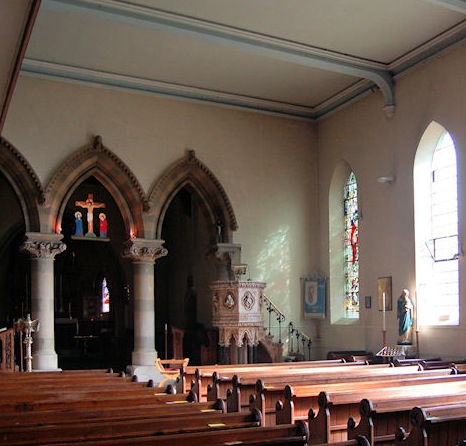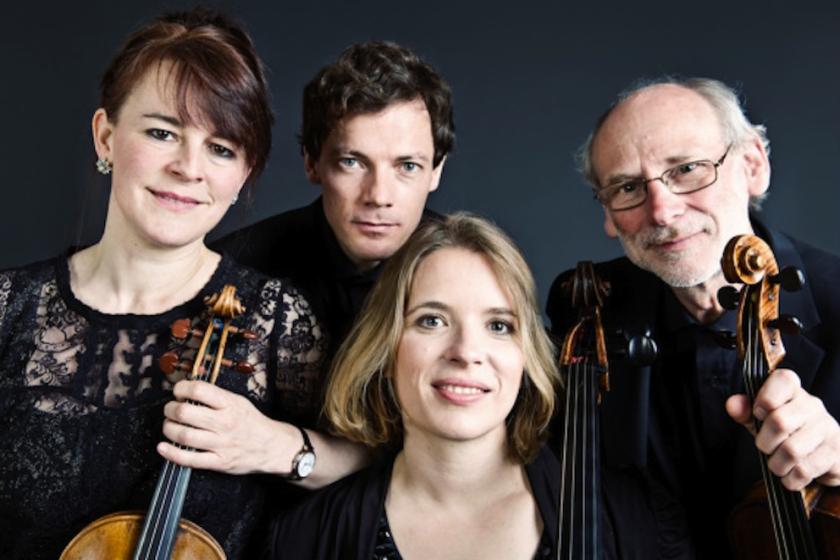If the thought of the annual trek to Hay-on-Wye for the literary festival in May fills you with as much gloom as it does me (and I don’t have to go as far as most of our readers), you might do worse than sample the town’s chamber music festival this weekend as a healthy change or at least a soothing antidote.
This is a new event crystallised out of an existing occasional series of concerts featuring the Fitzwilliam Quartet. And though it’s unlikely to spawn chamber music on every street corner of this small border town, in the way that bookshops once exploded out of Richard Booth’s original idea of an enormous clearing-house for second-hand books, it has already attracted a big following by the esoteric standards of the string quartet. Hay’s biggish parish church – an odd mixture of sub-Georgian, Victorian Gothic and neo-Byzantine (pictured below by John Ball), but with excellent acoustics – was packed for Friday’s opening concert.
 In its heyday the Fitzwilliam Quartet was famous for its association with Shostakovich. They worked with him and recorded all his quartets, the first group to do so. But for the most part this association is being kept for next year’s festival, and this year only the piano quintet figures (on Sunday afternoon). Friday’s inaugural concert trod a more classical path, but through a varied landscape of trios, quartets and, finally, Mendelssohn’s astonishing Octet, a work that hardly qualifies as chamber music at all. Mendelssohn himself wanted it played “in symphonic style”, and the Hay performance had the violinists and violists (the Fitzwilliam plus Marcia Crayford, Charlotte McClure, Suzie Mészáros and Moray Welsh) standing, like the Academy of St.Martin’s-in-the-Fields, a presentation that openly favours chamber music as theatre rather than conversation. The audience duly erupted at the end, as required; and indeed the playing, superbly uninhibited, deserved no less.
In its heyday the Fitzwilliam Quartet was famous for its association with Shostakovich. They worked with him and recorded all his quartets, the first group to do so. But for the most part this association is being kept for next year’s festival, and this year only the piano quintet figures (on Sunday afternoon). Friday’s inaugural concert trod a more classical path, but through a varied landscape of trios, quartets and, finally, Mendelssohn’s astonishing Octet, a work that hardly qualifies as chamber music at all. Mendelssohn himself wanted it played “in symphonic style”, and the Hay performance had the violinists and violists (the Fitzwilliam plus Marcia Crayford, Charlotte McClure, Suzie Mészáros and Moray Welsh) standing, like the Academy of St.Martin’s-in-the-Fields, a presentation that openly favours chamber music as theatre rather than conversation. The audience duly erupted at the end, as required; and indeed the playing, superbly uninhibited, deserved no less.
All the same, I found details more intriguing than the totality. The players divided antiphonally, as if Mendelssohn had written a double quartet, one left, one right, though the score doesn’t authorize any such arrangement and the writing is mostly not structured in that way. The composer was probably looking for depth of sound more than spacing (did he envisage an audience in his parents’ Berlin mansion, where the piece was first played, or was the intention simply to involve as many musicians as possible?). But it was fun watching the music fly around the semicircle, and the work certainly lost nothing in terms of energy or brilliance by virtue of this probably gratuitous architecture. The players themselves had a wonderful time and they carried us all along with them.
Barcham-Stevens’s Purcell is an excellent illustration of a postmodern approach to repertoireOn their own, the Fitzwilliam – reconstituted these days, and with only their viola player, Alan George, from the original team – played Haydn’s last F major Quartet, op.77 no.2, and a skilful and enjoyable fantasy on Purcell’s viol Fantasia no.11 by the quartet’s second violinist, Marcus Barcham-Stevens. They are still a very fine group, with a big, generous sound and a striking rhythmic impulse for which I particularly credit the leader, Lucy Russell, a wonderfully decisive player on this form. Sometimes, but not quite always, she was able to induce the same qualities in her colleagues: there were varying opinions about ornamentation and dotted notes in Haydn’s slow movement. But the texture of the playing was always beautiful and with a strong, irresistible presence.
Barcham-Stevens’s Purcell is an excellent illustration of a postmodern approach to repertoire. The original fantasy is made to flow almost imperceptibly into what one can hear as a modern equivalent of the intense vocal weave of Purcell’s string writing, which was itself old-fashioned in its day. Barcham-Stevens has apparently done other pieces along the same lines, and this “Double”, as he calls it, left me wanting to hear the others.














Add comment